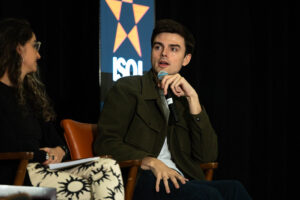Transparency, audience connection, understandable information and the use of emotions are some of the elements that journalists can learn from content creators, according to the speakers of the panel “Influencers/content creators and journalists: What can they learn from each other?,” celebrated on April 13, during the 25th International Symposium of Online Journalism (ISOJ).

“Influencers/content creators and journalists: What can they learn from each other?” Panel during the second day of the 25th ISOJ on April 13, 2024. (Patricia Lim/Knight Center)
The panel featured an international group of speakers that included Salla-Rosa Leinonen, producer at Yle Kioski (Finland); María Paulina Baena, journalist and co-creator of La Pulla (Colombia); Sam Ellis, creator and showrunner of Search Party (U.S.); and Hugo Travers, journalist and content creator at HugoDécrypte (France). The talk was moderated by Adeline Hulin, head of unit for Media and Information Literacy and Digital Competencies at UNESCO.
Hulin started the talk by announcing the project from UNESCO in partnership with the Knight Center for Journalism in the Americas to develop a massive open online course (MOOC) for digital news content creators and journalists, to foster the exchanges between them and explore what they can learn from each other.
One of the reasons for that initiative, she said, is that the world is seeing an increasing number of journalists who are becoming content creators and creating their own social media channels. At the same time, there’s a growing number of content creators focused on news reporting that are getting much bigger outreach than some traditional media outlets.
“There are many reasons to explain that phenomenon. [...] One of the reasons is that people are increasingly looking for a personalization of information,” Hulin said. “A recent survey of the Financial Times shows that news consumers place greater emphasis on the personal relation or the affinity of the person that produces or disseminates information in order to evaluate the trustworthiness of that information.”
When a journalist or a content creator starts producing content independently, without the backing of a media brand, they need to create a connection between the project and people, Ellis said. That often includes communicating directly with the audience and being on camera.
Appearing at the end of his videos to make announcements and adding scenes that explain how the video or part of it was made are some of the techniques Ellis has found effective for fostering that connection with the audience at Search Party, the YouTube-based video journalism project that he launched last year after he left his job at the digital news media outlet Vox.
“It’s important to show the work that you are doing. Most people don’t know what journalism takes. In a way, it has been more work, but it has been fun to kind of show people behind the curtain how we put together our videos and it’s a benefit for us as well,” he said.
Ellis said that showing people how content is created also adds transparency, which is another aspect that the audience values from influencers and social media personalities.
“[Transparency] is super important, without it you really can’t build a base. We use the community tab on YouTube a lot, just to remind people that we are around, that we are working,” he said. “In this era when trust may be declining in traditional journalism institutes, it’s important for us to show people that we are doing journalism and what it takes, so that the viewers see the difference between us and others.”

Hugo Travers (R) spoke at the 25th ISOJ. (Patricia Lim/Knight Center)
Leinonen said that, according to her research on what influencer-style journalism can bring to newsrooms, influencers and content creators tend to be more transparent than journalists in terms of showing how they do things. That can make digital creators sometimes more reliable than traditional media outlets in the eyes of the audience.
“I think that journalists have a lot to learn about that, so that people actually know about how they source the information, where the information is coming from, really basic stuff, but if the people would know more about that, I think it would make them more trustworthy,” she said.
Baena agreed with the benefits of showing the audience part of the behind the scenes of producing digital content. When a content creator appears on camera, she said, they become accountable to the public, which is beneficial in terms of transparency.
“You have to personalize the content and put your face in front of the camera, because people have to relate to someone, and that makes you accountable, too,” she said. “When you put your face on camera and you start talking to your audience, your audience starts to love or hate someone there, but you start making the information transparent.”
For Travers, being the public face of a digital channel doesn’t mean that the content has to be about the person. Even though his YouTube channel, HugoDécrypte, has his name on it, he said there’s no difference in views or engagement between the videos where he appears and the ones that feature other members of his staff.
“The format is more important than the personification. If the format is good, that also means that traditional media going online can create something valuable if the format is good itself and works,” he said.
However, Travers said that another important element that differentiates his content from the content of traditional media is the approach and the way of communicating a topic. He said that one of the reasons why he launched HugoDécrypte was because he didn’t understand much of what TV journalists were talking about regarding political issues.
“You have to explain those things. It’s not just a question of format, it’s also a question of writing and the script, of how you approach these topics so they are understandable and accessible for young audiences, and for people who want to get to understand those topics,” he said.
Ellis said that another important factor to take into consideration when a journalist transitions to an independent social media project is the publication pace, under the understanding that both social media users and platforms reward consistent rhythm of publication.
“Independent content creators-journalists just need to create a lot more, a lot faster. It has been an adjustment for me. To put that in perspective, when I was at Vox, I had about four to six weeks to do a video, enough time to do thorough journalism to take on big topics. At Search Party we try to publish about every three to four weeks, and that’s even slow for YouTube,” he said. “I learned a lot about work-flow efficiency, but there is a trade off there, and I think that does change a lot about the journalism that I do.”
Although the change of pace affects the kind of topics he can cover, Ellis said that he has found a way to handle that time constraint without affecting journalistic standards, which is to find smaller angles for big topics. For example, instead of producing a video that explained the Israel-Palestine conflict, he did one explaining how Arab governments had been normalizing their ties with Israel and how that had put them in a bind.
Ellis said that a YouTube journalism project allows for a broader spectrum of topics to cover, which makes the project attractive for a larger subscriber base.
One more element from influencers that could make journalism more appealing to people is bringing emotions to content, according to Baena.
“You can speak passionately about the topics that make you feel something, and that’s something that was not allowed when I was doing rigid journalism,” she said. “Something that La Pulla has taught me is that you can speak out loud of the things that make you mad [...]. So I think that rage and emotions are elements that you can take from content creators into a journalistic project.”
Baena said that La Pulla, the satirical and opinion journalism YouTube program of El Espectador newspaper, which she co-created, is an emotion-driven project. Baena explained that, when the La Pulla team is deciding the format of a piece of content, they think about what emotions are arising in people from what’s happening in Colombia. The emotions they identify are the emotions that they try to convey in the content.
“We make journalism emotional. Probably this breaks the laws of journalism of neutrality or seriousness because we inject a little bit of freshness and spontaneity to our content,” she said. “But this makes that, when we take sides in a story and make a point, this makes us not to be unfair with our audience and with what we see.”

(L to R) Salla-Rosa Leinonen and Sam Ellis were speakers at the 25th ISOJ. (Patricia Lim/Knight Center)
When it comes to making a difference between journalists and influencers that produce journalistic content, panelists agreed that they are comfortable thinking about themselves as being both things.
Travers said that he personally feels like something between a journalist and a content creator. Even though he started defining himself as a YouTuber when he launched HugoDécrypte in 2015, at the age of 18, he wanted to do journalism inspired by other YouTube channels he used to follow.
“Journalists have always been asking this question: ‘are you a journalist? Are you a YouTuber?’ And to be very precise, at the beginning of the channel, usually journalists weren’t asking, they were basically saying: ‘you are not a journalist.’ They were saying, ‘you are doing content on YouTube, you can’t do journalism on YouTube, that’s not journalism,’” he said.
Travers, who now has a master's degree in Communications, Media and Creative Industries, and leads a team of 25 people, 13 of them journalists, said that having official press IDs didn’t change anything the way he and his team work. He was even able to interview President Emmanuel Macron without having a press ID.
“I think our public doesn't care, really. As long as our work is serious and it has those ethics, just like journalists take ethics, I don’t think that people care if we define [ourselves] as YouTubers, or content creators, or journalists. What they want is reliable news sources,” he said.
That difference is not really something the audience is concerned about when consuming the content that is appealing to them, Baena also said.
“Am I a journalist, or am I a content creator, or am I both? I don’t care and I don’t think people care. The thing is that I have an audience to whom I am talking to,” she said. “Deep inside myself I feel [that I am] a journalist, but the thing is that I create a lot of content too. I learned from both landscapes what’s important in this whole era of having an audience and having something to say to that audience.”
The panelists’ points of view coincide with another finding of Leinonen's research. She found that journalists and content creators are closer to each other than many people might think from the audience point of view.
Similarly, according to her research, a lot of the audience’s expectations from journalists and creators are the same, such as authenticity and transparency, genuine engagement, a promise of quality content, and well-paced and consistent publication.
Leinonen also found that what defines “real journalism” are normative and traditional values, and that, unlike influencers, journalists often speak with authority. However, her research also found that influencers are more approachable and build closer connections with their followers, they have a personality-driven style, a deep understanding of a well-defined target audience, and specialized niche expertise.
“The biggest differences are what kind of rules and guidelines they follow, where they get their income, but these are things that most of the followers or the audience wouldn’t know, because it is not disclosed in the content,” Leinonen said. “It’s very important to understand that all these kinds of content creators on social media platforms, from the audience's point of view, don’t really look that different.”
When a question came up in the panel asking if it was healthy to allow any person to create digital content, the panelists agreed that media literacy is now more important than ever, because it’s neither possible nor advisable to try to stop people from creating content and uploading to digital platforms.
Given the fact that nowadays there are more and more people taking advantage of the blurred line between journalism and other types of content to publish misleading or unreliable content, the audience must learn to distinguish who are reliable sources of information, regardless of whether they are journalists or not, Travers said.
“I think it’s good to have everyone being able to publish stuff. […] That’s why I think the answer to this is education. The audience doesn’t care if it’s a journalist, or if it’s a content creator, or if it’s an influencer, or if it’s a politician. That’s a fact. And when you are on whatever platform, it’s not written ‘he is a journalist,’ or ‘he’s got a press card,’ or ‘he is a politician,’” Travers said. “You just need education and everyone needs to ask themselves who is speaking, why are they speaking, why are they publishing this content.”

María Paulina Baena spoke at the 25th ISOJ. (Patricia Lim/Knight Center)
Ellis said that journalists have always been content creators, with the only difference being that they are bound by a common set of rules and procedures. However, that doesn’t mean that any person can’t do some type of journalism.
“I really do think that anyone can wake up and do journalism for a day. […] What matters is the format that it is presented in,” he said. “I learned in my career from journalists about those rules and ethics, but I also learned from really talented artists about visual language, and about creative ways to present those ideas. So I think that there is a lot that people can learn from each other.”
Similarly, there are also things that content creators can learn from traditional journalists, according to Travers. He said that he and his team have learned a lot since they partnered with France’s public television to produce and broadcast interviews to politicians and culture personalities.
“They are not only broadcasting with us this program, they are also working with us on how to build such interviews, and I feel that we’ve got so many things to learn as content creators from these journalists,” he said. “Online content creators didn’t invent journalistic content creation, there have been for thousands of years traditional media building amazing pieces, amazing reports. I feel like building those bridges just helps everyone, helps journalism as a whole, and we have to keep pushing these links together.”